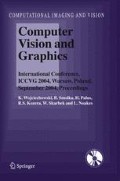Abstract
In classical photometric stereo, a Lambertian surface is illuminated from multiple distant point light-sources. In the present paper we consider nearby lightsources instead, so that the unknown surface, is illuminated by non-parallel beams of light. In continuous noiseless cases, the recovery of a Lambertian surface from non-distant illuminations, reduces to solving a system of non-linear partial differential equations for a bivariate function u, whose graph is the visible part of the surface. This system is more difficult to analyse than its counterpart, where light-sources are at infinity. We consider here a similar task, but with slightly more realistic assumptions: the photographic images are discrete and contaminated by Gaussian noise. This leads to a non-quadratic optimization problem involving a large number of independent variables. The latter imposes a heavy computational burden (due to the large matrices involved) for standard optimization schemes. We test here a feasible alternative: an iterative scheme called 2-dimensional Leap-Frog Algorithm 14. For this we describe an implementation for three light-sources in sufficient detail to permit code to be written. Then we give examples verifying experimentally the performance of Leap-Frog.
Access this chapter
Tax calculation will be finalised at checkout
Purchases are for personal use only
Preview
Unable to display preview. Download preview PDF.
REFERENCES
Brooks, M. J., Chojnacki, W., and R., Kozera (1992). Impossible and ambiguous shading patterns. Int. J. Comp. Vision, 7(2): 119–126.
Frankot, R. T. and Chellappa, R. (1988). A method of enforcing integrability in shape from shading algorithms. IEEE Trans. Patt. Rec. Machine Intell., 10(4):439–451.
Hackbush, W. (1994). Iterative Solution of Large Sparse Systems of Equations. Springer, New York, Heidelberg, Berlin.
Horn, B. K. P. (1986). Robot Vision. McGraw-Hill, New York Cambridge, MA.
Horn, B. K. P. (1990). Height and gradient from shading. Int. J. Comp. Vision, 5(1):37–75.
Hurt, N. E. (1991). Mathematical methods in shape-from-shading: a review of recent results. ActaAppl. Math., 23:163–188.
Kozera, R. (1991). Existence and uniqueness in photometric stereo. Appl. Math. Comput., 44(1):1–104.
Kozera, R. (1992). On shape recovery from two shading patterns. Int. J. Patt. Rec. Art. Intel. 6(4):673–698.
Kozera, R. (1995). On complete integrals and uniqueness in shape from shading. Appl. Math. Comput., 73(1): 1–37.
Kozera, R. (1997). Uniqueness in shape from shading revisited. J. Math. Imag. Vision, 7:123–138.
Noakes, L. (1999). A global algorithm for geodesics. J. Math. Australian Soc. Series A, 64:37–50.
Noakes, L. and Kozera, R. (2001). The 2-D Leap-Frog, noise, and digitization. In Bertrand, G., Imiya, A., and Klette, R., editors, Digital and Image Geometry, volume 2243 of Lect. Notes Comp. Sc., pages 352–364, Berlin Heidelberg. Springer-Verlag.
Noakes, L. and Kozera, R. (2002). Denoising images: non-linear Leap-Frog for shape and light-source recovery. In Asano, T., Klette, R., and Ronse, C., editors, Geometry, Morphology, and Computational Imaging, volume 2616 of Lect. Notes Comp. Sc., pages 419–436, Berlin Heidelberg. Springer-Verlag.
Noakes, L. and Kozera, R. (2003). Nonlinearities and noise reduction in 3-source photometric stereo. J. Math. Imag. Vision, 18(3): 119–127.
Oliensis, J. (1991). Uniqueness in shape from shading. Int. J. Comp. Vision, 6(2):75–104.
Onn, R. and A., Bruckstein (1990). Uniqueness in shape from shading. Int. J. Comp. Vision, 5(1):105–113.
Simchony, T., Chellappa, R., and Shao, M. (1990). Direct analytical methods for solving Poisson equations in computer vision problems. IEEE Trans. Patt. Rec. Machine Intell., 12(5):435–446.
Author information
Authors and Affiliations
Editor information
Editors and Affiliations
Rights and permissions
Copyright information
© 2006 Springer
About this chapter
Cite this chapter
Kozera, R., Noakes, L. (2006). NOISE REDUCTION IN PHOTOMETRIC STEREO WITH NON-DISTANT LIGHT SOURCES. In: Wojciechowski, K., Smolka, B., Palus, H., Kozera, R., Skarbek, W., Noakes, L. (eds) Computer Vision and Graphics. Computational Imaging and Vision, vol 32. Springer, Dordrecht. https://doi.org/10.1007/1-4020-4179-9_16
Download citation
DOI: https://doi.org/10.1007/1-4020-4179-9_16
Publisher Name: Springer, Dordrecht
Print ISBN: 978-1-4020-4178-5
Online ISBN: 978-1-4020-4179-2
eBook Packages: Computer ScienceComputer Science (R0)

